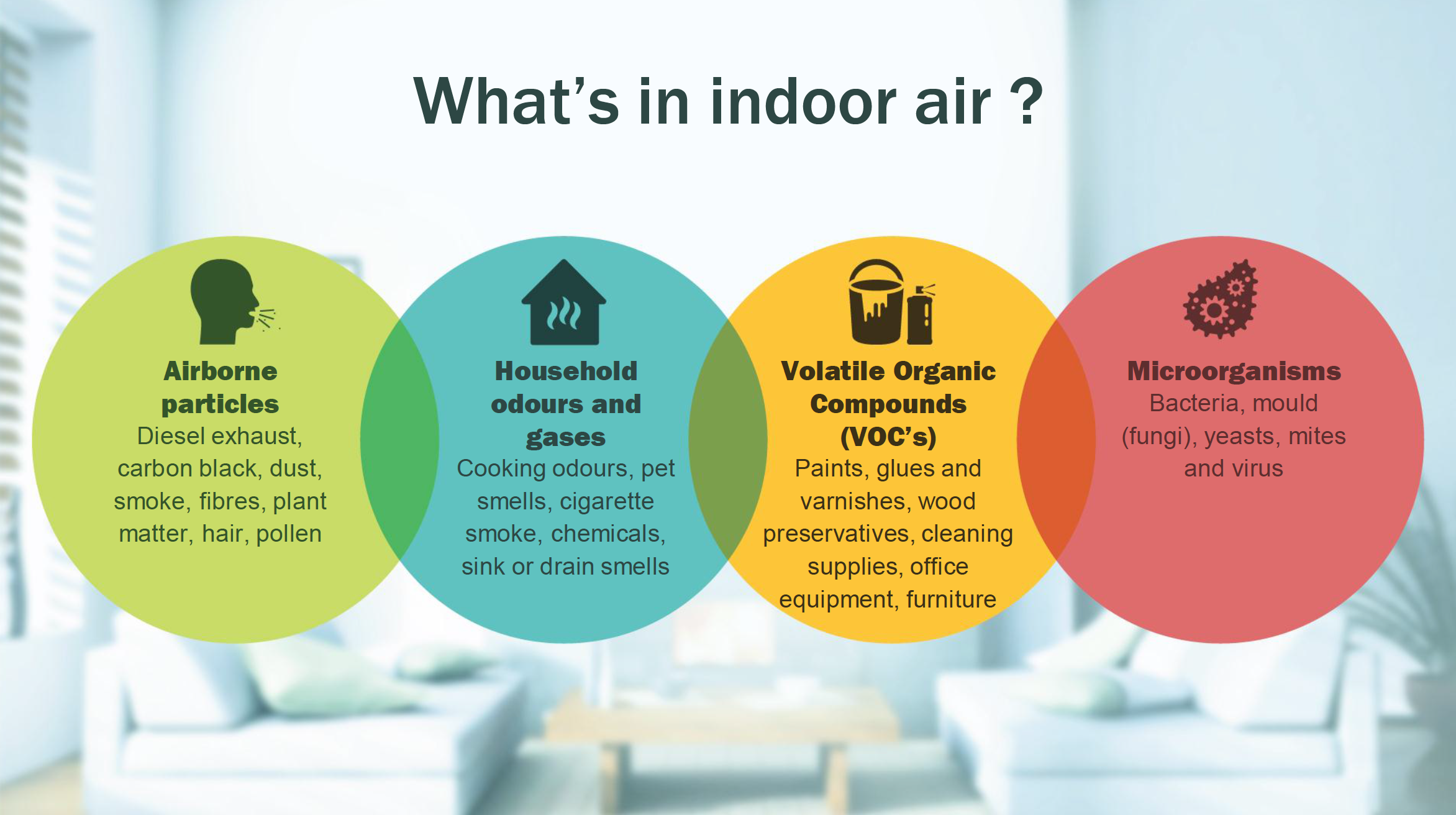
Indoor air quality plays a crucial role in our overall health and well-being, impacting everything from our cognitive function to our vulnerability to diseases. In recent studies, indoor air pollution has been linked to a variety of health effects, including respiratory issues and decreased mental clarity, making it essential for us to pay close attention to the air we breathe indoors. As we spend approximately 80% of our lives inside buildings, understanding the dynamics of healthy buildings is more important than ever. Creating an environment with improved indoor spaces not only helps reduce pollutants but also enhances our focus and problem-solving abilities. Therefore, prioritizing indoor air quality is a vital step towards fostering healthier living and working environments for everyone.
The condition of the air we breathe within closed environments, often referred to as environmental air quality, significantly affects our daily lives. Factors such as indoor air contaminants, along with the management of ventilation and humidity, can have pronounced effects on our physical and mental health. Exploring the impact of these elements on well-being sheds light on why creating healthy structures is paramount. With the right strategies for enhancing our indoor environments, we can not only mitigate the adverse consequences of poor air quality but also boost our cognitive abilities and productivity. Recognizing the importance of good air quality may very well be the key to unlocking the potential of our indoor spaces.
Understanding Indoor Air Quality and Health Effects
Indoor air quality (IAQ) significantly influences our overall health and well-being. It is essential to recognize that the air we breathe indoors can contain pollutants that contribute to various health problems, including respiratory issues, headaches, and cognitive decline. Poor indoor air quality is often caused by inadequate ventilation, chemicals from cleaning products, building materials, and mold growth. Understanding these aspects not only helps in creating healthier indoor spaces but also in mitigating the adverse health effects associated with indoor air pollution.
Many people are unaware that they spend as much as 90% of their time indoors, making the quality of that air critical. A 2015 study by Harvard highlighted that enhancing ventilation can improve cognitive function substantially. This emphasizes the need for building owners and employers to prioritize indoor air quality as part of their health and wellness strategies. By doing so, organizations can foster healthier environments that promote better focus, productivity, and general health.
The Impact of Indoor Air Pollution on Cognitive Function
Research has shown that poor indoor air quality correlates with decreased cognitive function. Increased levels of indoor air pollutants, such as CO2 and volatile organic compounds (VOCs), can impair decision-making abilities and critical thinking. Employees working in poorly ventilated spaces may struggle to concentrate, leading to a decline in productivity. Such findings underline the importance of recognizing how indoor air quality not only affects physical health but also cognitive performance.
Improving indoor air quality is not just about comfort; it’s about enhancing cognitive capabilities. Simple interventions, such as increasing air ventilation rates and utilizing air purifiers with HEPA filters, can lead to significant improvements in cognitive function. Organizations should consider these measures to transform their workspaces into healthy buildings conducive to both health and productivity.
Creating Healthy Buildings for a Better Tomorrow
The concept of healthy buildings goes beyond just structural integrity; it encompasses the very air we breathe and how our surroundings affect our health. Buildings should be designed to promote wellness through improved indoor air quality, natural light, and effective ventilation systems. Emphasizing the importance of indoor air quality in building design can dramatically reduce the incidence of illness among occupants, fostering a healthier workforce.
To achieve this, architects and facility managers need to collaborate closely, implementing solutions that address indoor air pollution. Upgrading HVAC systems, utilizing non-toxic building materials, and regularly monitoring air quality are crucial steps. The future of building design should focus on creating environments that promote health and well-being, not just aesthetics or functionality.
Strategies for Improving Indoor Spaces
Improving indoor spaces requires a multifaceted approach focused on enhancing air quality. This can be accomplished through increased ventilation, using air purifiers, and incorporating more plants into the workspace, which can naturally filter pollutants. Regular maintenance of heating and cooling systems is also essential to ensure that airflow remains unobstructed and clean. By adopting these strategies, individuals and organizations can take significant steps towards optimizing their indoor environments.
Furthermore, educating occupants about the impact of their activities on indoor air quality can lead to healthier behavior patterns. Simple actions, such as minimizing the use of candles or synthetic fragrances, can have profound effects on the air quality within homes and workplaces. By fostering awareness and encouraging proactive measures, it is possible to create healthier indoor spaces conducive to wellness and productivity.
The Role of Air Quality in Workplace Wellness Programs
Incorporating air quality improvements into workplace wellness programs is vital for enhancing overall employee health. By recognizing the direct link between indoor air quality and employee well-being, businesses can develop initiatives that prioritize clean air in the workplace. This not only leads to healthier employees but also contributes to increased productivity and job satisfaction.
Workplace wellness programs should include regular air quality assessments and actionable steps to mitigate indoor air pollution. This may involve training staff on proper cleaning techniques that do not compromise air quality, as well as establishing guidelines for maintaining optimal ventilation. A focus on improving indoor air can lead businesses to create a thriving and resilient workforce.
Monitoring Indoor Air Quality: Tools and Techniques
Monitoring indoor air quality is essential for maintaining healthy environments. Various tools and technologies are available to assess air quality, including sensors that measure levels of CO2, VOCs, and particulate matter. Implementing these tools allows for real-time data collection, providing insights into pollutants that may affect health and productivity.
Regularly monitoring indoor air quality not only improves awareness but also facilitates timely interventions. Building managers can make informed decisions about when to increase ventilation or filter air more frequently based on collected data. This proactive approach to air quality management can significantly reduce the health effects associated with indoor air pollution.
The Future of Indoor Air Quality in Building Design
As awareness about the importance of indoor air quality grows, the future of building design is likely to shift towards incorporating strategies that prioritize health. Architects and builders are increasingly focusing on ventilation and materials that do not release harmful chemicals. The integration of smart technology can further enhance indoor air quality by automating ventilation systems based on occupancy and air quality levels.
Innovative designs that prioritize natural ventilation and use sustainable materials will become paramount in creating healthy buildings. As more research reveals the links between environment and health, it will be essential for the construction industry to embrace practices that not only meet aesthetic standards but also enhance indoor air quality for the well-being of occupants.
Legislation and Policy on Indoor Air Quality Standards
Governments play a crucial role in establishing regulations that govern indoor air quality standards. Strong policies can help ensure that buildings are designed and maintained in ways that protect occupant health. As the understanding of indoor air pollution’s effects on public health continues to evolve, there is a growing demand for stricter regulations on indoor air quality.
Advocating for policies that promote healthy buildings and better indoor air quality can lead to substantial public health improvements. Collaboration among health organizations, policymakers, and construction industries is essential in shaping effective legislation that prioritizes the health of communities in relation to indoor environments.
Exploring the Economic Benefits of Healthy Indoor Spaces
Investing in healthy indoor spaces yields numerous economic benefits. Companies that prioritize indoor air quality can see a significant return on investment through improved employee productivity, reduced sick days, and lower healthcare costs. Healthy indoor environments not only enhance individual well-being but also promote corporate success by ensuring that employees perform at their best.
Moreover, as public awareness grows regarding the effects of indoor air quality, tenants and buyers will favor properties that boast healthy design features. This shift in demand can elevate property values and increase marketability, making it economically advantageous for developers and landlords to invest in strategies that enhance indoor air quality.
Frequently Asked Questions
What are the health effects of indoor air pollution?
Indoor air pollution can lead to various health issues including respiratory problems, headaches, and fatigue. Long-term exposure may contribute to chronic diseases such as asthma and cardiovascular conditions, highlighting the importance of maintaining good indoor air quality.
How can improving indoor spaces enhance cognitive function?
Improving indoor air quality through increased ventilation and proper filtration can significantly enhance cognitive function. Studies show that better air quality correlates with improved focus and problem-solving abilities, making healthy buildings essential for productivity.
What are some common sources of indoor air pollution?
Common sources of indoor air pollution include mold, radon, volatile organic compounds (VOCs) from paints and cleaning products, tobacco smoke, and dust. Identifying and mitigating these sources is crucial for maintaining a healthy indoor environment.
How does indoor air quality affect health at work?
Indoor air quality plays a vital role in workplace health. Poor air quality can lead to decreased employee productivity, increased sick days, and overall lower morale. Ensuring healthy buildings with proper ventilation can positively impact employees’ well-being and efficiency.
What steps can I take to improve indoor air quality in my home?
To improve indoor air quality, consider increasing ventilation, using air purifiers with HEPA filters, regularly cleaning and dusting, and minimizing the use of VOC-emitting products. These actions can help create healthier living spaces.
Is outdoor air pollution worse than indoor air pollution?
Surprisingly, indoor air pollution can often be more harmful than outdoor air pollution, as pollutants can accumulate and be trapped indoors. Ensuring good ventilation and air quality management is essential for reducing indoor health risks.
What impact does air quality have on children’s health?
Children are especially vulnerable to the effects of indoor air pollution, which can exacerbate allergies, asthma, and developmental issues. Maintaining high indoor air quality is critical for their health and overall development.
Which indoor air quality measures are most effective in reducing illness?
Effective measures to reduce illness related to indoor air quality include increasing outdoor air intake, enhancing filtration systems, and using air purifiers. These strategies can help minimize the spread of infectious diseases and improve overall health.
How important is ventilation for indoor air quality?
Ventilation is crucial for maintaining indoor air quality as it helps to dilute and remove indoor pollutants. Properly designed ventilation systems can significantly improve cognitive function and overall well-being in both homes and workplaces.
Can you explain the relationship between indoor air quality and healthy buildings?
Healthy buildings prioritize indoor air quality as a key component of occupant health. By ensuring proper ventilation, minimizing pollutants, and using non-toxic materials, these buildings contribute to better health outcomes and improved cognitive function.
| Key Point | Details |
|---|---|
| Health Impact of Indoor Air Quality | Poor indoor air quality can lead to health issues such as fatigue, decreased concentration, and increased incidence of diseases. |
| Time Spent Indoors | Americans spend approximately 80% of their lives indoors, making indoor air quality crucial for health. |
| Cognitive Function and Workplace | Studies indicate that improved air ventilation in buildings can enhance workers’ cognitive function. |
| Air Ventilation Changes | Changes in building ventilation rates started in the 1970s primarily to reduce complaints related to odors and improve air quality. |
| Indoor Air Pollution Sources | A significant amount of indoor air pollution comes from outside, but also from other indoor sources such as neighboring apartments. |
| Disease Prevention | Actions like increasing outdoor air intake, improving filtration, and using HEPA filters can significantly reduce the spread of infections. |
| Chemical Risks | There are over 80,000 chemicals used commercially in America, and only 200 have been banned by the EPA since 1976, indicating ongoing risks. |
Summary
Indoor air quality plays a crucial role in our overall health, particularly as we spend so much time indoors. The conditions we face in our homes, workplaces, and schools can significantly affect our concentration, well-being, and risk of illness. It is essential to address indoor air quality issues to enhance our living and working environments, thereby promoting better health and productivity.





